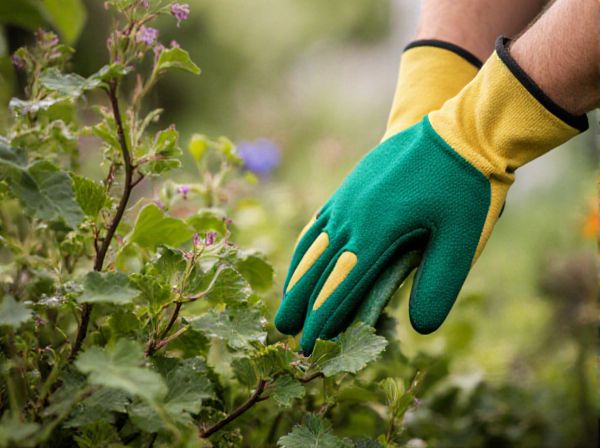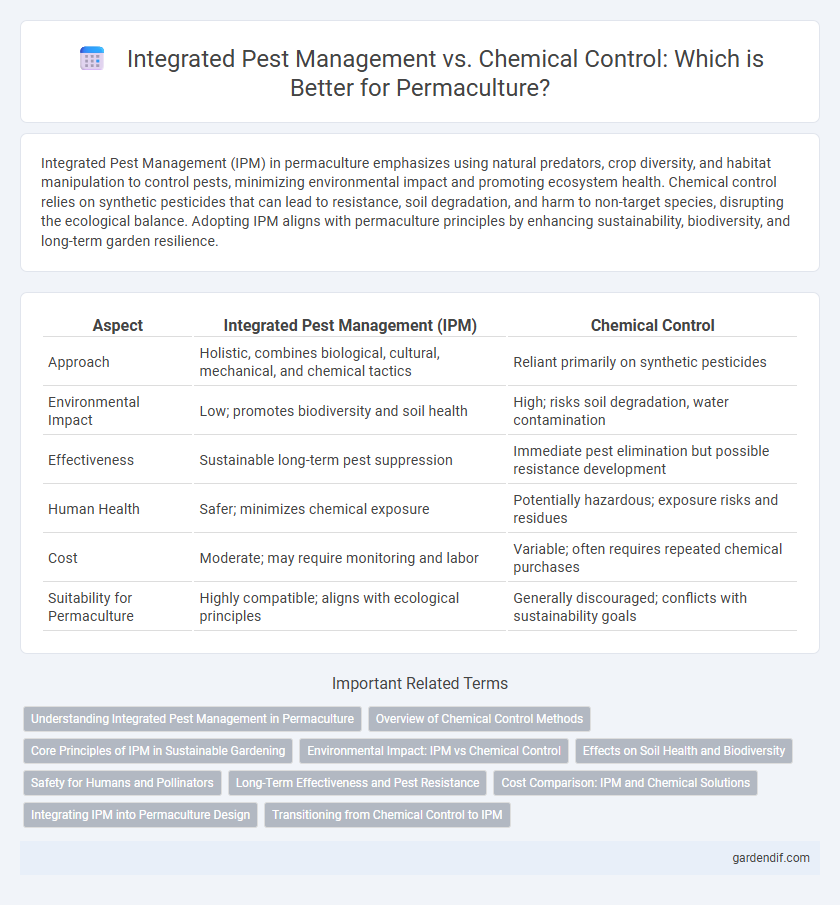
Integrated Pest Management vs Chemical Control Illustration
Integrated Pest Management (IPM) in permaculture emphasizes using natural predators, crop diversity, and habitat manipulation to control pests, minimizing environmental impact and promoting ecosystem health. Chemical control relies on synthetic pesticides that can lead to resistance, soil degradation, and harm to non-target species, disrupting the ecological balance. Adopting IPM aligns with permaculture principles by enhancing sustainability, biodiversity, and long-term garden resilience.
Table of Comparison
| Aspect | Integrated Pest Management (IPM) | Chemical Control |
|---|---|---|
| Approach | Holistic, combines biological, cultural, mechanical, and chemical tactics | Reliant primarily on synthetic pesticides |
| Environmental Impact | Low; promotes biodiversity and soil health | High; risks soil degradation, water contamination |
| Effectiveness | Sustainable long-term pest suppression | Immediate pest elimination but possible resistance development |
| Human Health | Safer; minimizes chemical exposure | Potentially hazardous; exposure risks and residues |
| Cost | Moderate; may require monitoring and labor | Variable; often requires repeated chemical purchases |
| Suitability for Permaculture | Highly compatible; aligns with ecological principles | Generally discouraged; conflicts with sustainability goals |
Understanding Integrated Pest Management in Permaculture
Integrated Pest Management (IPM) in permaculture emphasizes ecological balance by integrating natural predators, crop diversity, and habitat manipulation to manage pest populations sustainably. This approach reduces reliance on chemical pesticides, promoting soil health, biodiversity, and long-term resilience of agroecosystems. Implementing IPM supports permaculture's core principles of closed-loop systems and regenerative agriculture.
Overview of Chemical Control Methods
Chemical control methods in permaculture involve the targeted use of synthetic pesticides, herbicides, and insecticides to manage pest populations. These substances can offer rapid and effective pest suppression but may disrupt beneficial insects, soil health, and ecosystem balance. Sustainable permaculture practices prioritize minimizing chemical inputs to preserve biodiversity and promote long-term ecological resilience.
Core Principles of IPM in Sustainable Gardening
Integrated Pest Management (IPM) in sustainable gardening emphasizes ecosystem balance, using biological controls, habitat manipulation, and cultural practices to minimize pest damage while reducing chemical inputs. Core principles include monitoring pest populations, setting action thresholds, and applying targeted treatments that preserve beneficial organisms and soil health. This approach promotes long-term pest suppression, enhances biodiversity, and supports resilient garden ecosystems without reliance on harmful synthetic pesticides.
Environmental Impact: IPM vs Chemical Control
Integrated Pest Management (IPM) minimizes environmental impact by promoting natural predators and using targeted, eco-friendly techniques that reduce pesticide runoff and soil contamination. Chemical control relies heavily on synthetic pesticides, which can lead to biodiversity loss, water pollution, and pesticide resistance in pest populations. IPM's sustainability helps maintain ecosystem balance while chemical control often disrupts habitats and harms non-target species.
Effects on Soil Health and Biodiversity
Integrated Pest Management (IPM) enhances soil health by promoting natural pest predators and reducing reliance on synthetic chemicals, which preserves microbial diversity and soil structure. Chemical control methods often degrade soil quality by disrupting beneficial organisms, leading to diminished nutrient cycling and increased vulnerability to pests. Emphasizing IPM supports biodiversity by maintaining balanced ecosystems, whereas chemical controls tend to cause declines in non-target species and overall ecological resilience.
Safety for Humans and Pollinators
Integrated Pest Management (IPM) prioritizes human and pollinator safety by using biological controls, habitat manipulation, and targeted interventions that minimize chemical exposure. Chemical control relies on pesticides that can pose significant risks to non-target species, including beneficial insects like bees and other pollinators, as well as potential health hazards to humans through residue and environmental contamination. IPM's emphasis on sustainable, low-toxicity methods supports ecosystem health and reduces the risk of poisoning and ecological disruption inherent in conventional chemical treatments.
Long-Term Effectiveness and Pest Resistance
Integrated Pest Management (IPM) emphasizes ecosystem balance by combining biological controls, habitat manipulation, and selective pesticide use, resulting in sustainable pest suppression with reduced risk of resistance development. Chemical control often provides rapid pest elimination but can lead to increased pest resistance and environmental harm over time due to repeated, broad-spectrum pesticide applications. Long-term effectiveness of IPM is enhanced by maintaining natural predator populations and promoting biodiversity, which contributes to resilient agricultural systems and minimizes reliance on synthetic chemicals.
Cost Comparison: IPM and Chemical Solutions
Integrated Pest Management (IPM) reduces long-term costs by combining biological controls, crop rotation, and monitoring techniques that minimize pesticide use and prevent pest resistance. Chemical control often involves higher immediate expenses for purchasing synthetic pesticides and repeated applications, while increasing risks of environmental damage and pest resurgence. Over time, IPM lowers overall expenses and enhances sustainability by promoting ecosystem health and reducing dependency on costly chemical inputs.
Integrating IPM into Permaculture Design
Integrating Integrated Pest Management (IPM) into permaculture design enhances sustainable agriculture by combining biological controls, habitat manipulation, and cultural practices to naturally reduce pest populations without relying on synthetic chemicals. This approach promotes ecosystem balance and biodiversity, supporting predator species and soil health while minimizing chemical runoff and resistance. IPM aligned with permaculture principles ensures long-term pest suppression through diversified planting and ecological resilience, improving crop yield and environmental safety.
Transitioning from Chemical Control to IPM
Transitioning from chemical control to Integrated Pest Management (IPM) enhances sustainable agriculture by reducing reliance on synthetic pesticides and promoting ecological balance. IPM combines biological control, habitat manipulation, and cultural practices to manage pest populations effectively while minimizing environmental impact. Adopting IPM supports soil health, biodiversity, and long-term farm productivity in permaculture systems.
Integrated Pest Management vs Chemical Control Infographic

 gardendif.com
gardendif.com